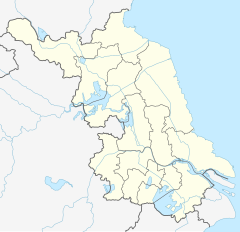Qixia Temple (simplified Chinese: 栖霞寺; traditional Chinese: 棲霞寺; pinyin: Qīxiá Sì) is a Buddhist temple located on Qixia Mountain[1] in the suburban Qixia District of Nanjing, Jiangsu, 22 kilometres (14 mi) northeast of downtown Nanjing.[2] It is one of Nanjing's most important Buddhist monasteries. The temple is the cradle of East Asian Mādhyamaka.[3]
| Qixia Temple | |
|---|---|
栖霞寺 | |
 The Pilu Hall of the temple | |
| Religion | |
| Affiliation | Buddhism |
| Sect | East Asian Mādhyamaka |
| Location | |
| Location | Qixia District, Nanjing, Jiangsu |
| Country | China |
| Geographic coordinates | 32°09′15″N 118°57′14″E / 32.15417°N 118.95389°E |
| Architecture | |
| Style | Chinese architecture |
| Founder | Sengshao (僧绍) |
| Date established | AD 489 |
| Completed | 1919 (reconstruction) |
History edit
Built in AD 489, the 7th year of the Yongming era during the Southern Qi dynasty (479–502),[4] the temple is known for its large collection of Chinese Buddhist visual art and sculptural art in the grounds.[2][3] These consist of pagodas, murals and artwork that date back to the 10th century.[4]
It has had several names over the centuries, including the "Gongde Temple" (功德寺; Tang dynasty), "Miaoyin Temple" (妙音寺; Southern Tang dynasty), "Puyun Temple" (普云寺; Song dynasty), "Yanyin Chongbao Chan Temple" (严因崇报禅院; Song dynasty), "Jingde Qixia Temple" (景德栖霞寺; Song dynasty) and "Huxue Temple" (虎穴寺; Song dynasty).[3]
In 1372, at the dawn of Ming dynasty (1368–1644), the temple was renamed "Qixia Temple" which is still in use now.[3]
In the late Qing dynasty (1644–1911), Qixia Temple was completely destroyed by the Taiping Rebellion.[3]
The modern restoration of the entire temple complex was carried out in 1919, after the establishment of the Republic of China.[3] During the Nanjing Massacre, the temple was a temporary refuge of four months for more than 24,000 civilians fleeing the masscare.[5] The incident was reenacted into a movie Qixia Temple 1937, which helped in boosting visitorship to the temple.[6]
Near the temple site and situated on the slopes of Qixia Hill, is the "Thousand Buddha Caves", a grotto containing many Buddhist sculptural works of art.[4]
Description edit
Buddha's Relics Pagoda edit
The Qixia Stupa (栖霞塔) or Buddha's Relics Pagoda is in the southeast of Qixia Temple. It was built in 601 and destroyed in the Tang dynasty (618–907). In 945, it was rebuilt by Southern Tang dynasty emperor Li Jing.[7][8]
The pagoda has a five-story, octagon-shaped structure. It is 18-metre (59 ft) high and perched on a two-story stylobate carved with waves and a dash of fish and Chinese flowering crab apples.[7][8]
Pilu Hall edit
Behind the Mahavira Hall is the Pilu Hall (毗卢殿) enshrining the statues of Vairocana, Brahma and Indra. At the back of Vairocana's statue are statues of Guanyin, Longnü and Sudhana. The statues of the Twenty Devas stand on both sides of the hall.[3]
Pavilion of Giant Buddha edit
The statue of Amitābha is enshrined in the Pavilion of Giant Buddha (大佛阁). It was built in the 5th century during the Southern Qi dynasty (479–502). The sitting statue is 10.8-metre (35 ft) high and 13.3-metre (44 ft) high adding the throne. Statues of Guanyin and Mahasthamaprapta stand on the left and right sides of Amitābha's statue. In front of the pavilion there are two statues of Guiding Buddha of the Qixia Stupa, both are more than 3-metre (9.8 ft) high.[9]
Thousand Buddha Rock edit
To east side of the Qixia Stupa is the Thousand Buddha Rock (千佛岩), the only Buddhist grottoes of the Southern dynasties (420–589) in China. There are 297 Buddhist niches and 515 statues. In the following dynasties, such as Tang (618–907), Song (960–1279), Yuan (1271–1368) and Ming dynasties (1368–1644), statues were also carved. Totally there are more than 700 statues.[10]
Alumni edit
Hsing Yun edit
Hsing Yun, the founder of Taiwan's Fo Guang Shan, is Qixia Temple’s most notable alumnus in the contemporary period. He was tonsured at Qixia Temple in 1941. He was a disciple of Master Zhikai and studied for several years at the Qixia Vinaya School.[8]
References edit
- ^ "Qixia Mountain". Foreignercn.com. 2009-09-30. Retrieved 2018-01-13.
- ^ a b Zi Yan (2012), p. 82.
- ^ a b c d e f g Zhang Yuhuan (2012), p. 225.
- ^ a b c Qixia Temple
- ^ "南京大屠杀时,这个和尚一句谎言救了2万多人,包括一位抗战名将_日本". www.sohu.com. Retrieved 2021-09-18.
- ^ "Monk turned film backer finds safer ground with depiction of war heroism". South China Morning Post. 11 February 2008. Retrieved 2021-09-18.
- ^ a b Zi Yan (2012), p. 83.
- ^ a b c Zhang Yuhuan (2012), p. 226.
- ^ Zi Yan (2012), p. 84.
- ^ Zi Yan (2012), p. 85.
Bibliography edit
- Zi Yan (2012). Famous Temples in China (in English and Chinese). Hefei, Anhui: Huangshan Publishing House. pp. 54–57. ISBN 978-7-5461-3146-7.
- Zhang Yuhuan (2012). "The Cradle of East Asian Mādhyamaka: Qixia Temple" 《三论宗祖庭:栖霞寺》. 《图解中国佛教建筑》 [Illustration of Buddhist Architecture in China] (in Chinese). Beijing: Contemporary China Publishing House. ISBN 978-7-5154-0118-8.

